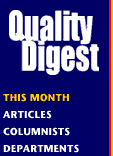|
|
|
|
Today's Specials |
|
|
|
|
Ask the Experts
Selecting a registrar I'm employed by a nonprofit professional association, and I'd like to establish a vendor-certification program so that our association members can make informed decisions regarding third-party service providers. How do I get started? --Perplexed in Peoria
It
sounds like you're looking for guidance on developing a program to qualify registrars based on their competency to provide third-party audits of facilities that your association's member organizations operate. Jim Mroz,
editor of "The Informed Outlook" newsletter, suggests the following steps: 1. Consider whether your association's member organizations all engage in the same types of activities (e.g., aerospace
manufacturing). If so, you should identify the Standardized Industrial Classification codes or the NACE codes by which these organizations are covered because registrars are accredited by most accreditation bodies to
conduct registration assessments within certain SIC or NACE Codes (NACE Codes differ from SIC Codes in how they group activities, but there are equivalents). If you are able to identify a subset of codes that cover the
activities of your association's members, you can use that subset to identify those registrars accredited to offer third-party services for the members (and exclude those that aren't). 2. Contact your
association's members to ask those who are already registered which registrars they used, what their reactions to the registrars were and whether they would recommend their registrar to other association members.
Referrals are a good way to go. 3. Verify what type of accreditation your association would value. For instance, if your association's members have facilities located in one specific country, they might
want to use registrars accredited by that country's accreditation body. Likewise, if the members have facilities involved in international trade, certain accreditation bodies (e.g., RAB, RvA and UKAS) are more widely
recognized internationally. 4. For which standard or set of requirements are registration assessments being sought? Some registrars provide only quality management system or environmental management system
auditing, which could be a factor. 5. Where are the association members located? It's sometimes cost-effective to use a registrar close to an organization's facilities because this reduces travel costs. 6. What critical issues does your association want to focus on in recommending guidelines for members selecting registrars? Depending on the issues, you may want to "interview" a number of
registrars to see which suit the philosophy and auditing approach of your association's members.
Understanding QS-9000 I'm confused about a portion of clause 4.11.1 in QS-9000 that reads, "Inspection, measuring and test equipment shall be used in a manner which ensures that the measurement uncertainty is known and is consistent with the required measurement capability." I'm the management representative and I'm in the process of revising our internal audit checklist questions. If I can't understand it, how can my auditors? --Muddled in Memphis
The statement means that you don't use a yardstick to measure clock parts, according to John A. Bruman, quality assurance manager at Precision Die and Stamping Inc. in Tempe, Arizona. "It requires that inspection and measuring tools are selected and specified in your documentation according to their known capabilities regarding resolution, accuracy, linearity, and repeatability and reproducibility," he explains. "It doesn't necessarily mean a formal R&R analysis must be performed on each and every tool, but you should have some evidence that you know the capabilities of each type of tool or device." Gage R&R was originally used as a diagnostic routine to verify the results of a designed experiment or process capability study. "I recently had a customer insist that a separate gage R&R should be done for each special characteristic on every control plan," recalls Bruman. "I finally convinced the customer that gage R&R doesn't change significantly with part number, date, characteristic size or phase of the moon. The only exception is the possibility of a linearity problem, in which case, maybe a better gage should be chosen to begin with. A standing file of the R&R capability of, say, a one-inch micrometer should be admissible for any dimension from zero to one inch (on any part) provided that it's used in essentially the same manner and demonstrates the required accuracy."
When do documents get "re-approved"? ISO 9001:2000's clause 4.2.3.b states: "A documented procedure shall be established to define the controls needed to review and update as necessary and re-approve documents." Does this mean that we have to periodically review documents, say on an annual basis or as required by changes? --Baffled in Buffalo
The standard does not require documents to be reviewed at set times. "When you are performing internal audits, you are fulfilling part of this requirement," says Eileen V. Wall, ISO coordinator at GNB Industrial Power in Columbus, Georgia. "You're actually only fulfilling part of the requirement because an audit is a sampling and not a review of the entire system." Documents only need to be "re-approved" if you're updating a documented process. "You should have some system in place to handle a revision or change to procedures, no matter what level document," advises Wall. "ISO 9001:1994 required that the same group that originally approved the document be involved in approving any updates. Therefore, you should already have some type of review and update procedure in place."
Got questions? We've got answers If you've got questions you'd like our panel of experts to tackle, e-mail them to experts@qualitydigest.com . We can't guarantee a response or that your questions will be printed, but we'll do our best. |
Menu Level Above
This Menu LeveL
Menu Level Below
Copyright 2000 QCI International. All rights reserved.
Quality Digest can be reached by phone at (530) 893-4095. E-mail: Click Here


